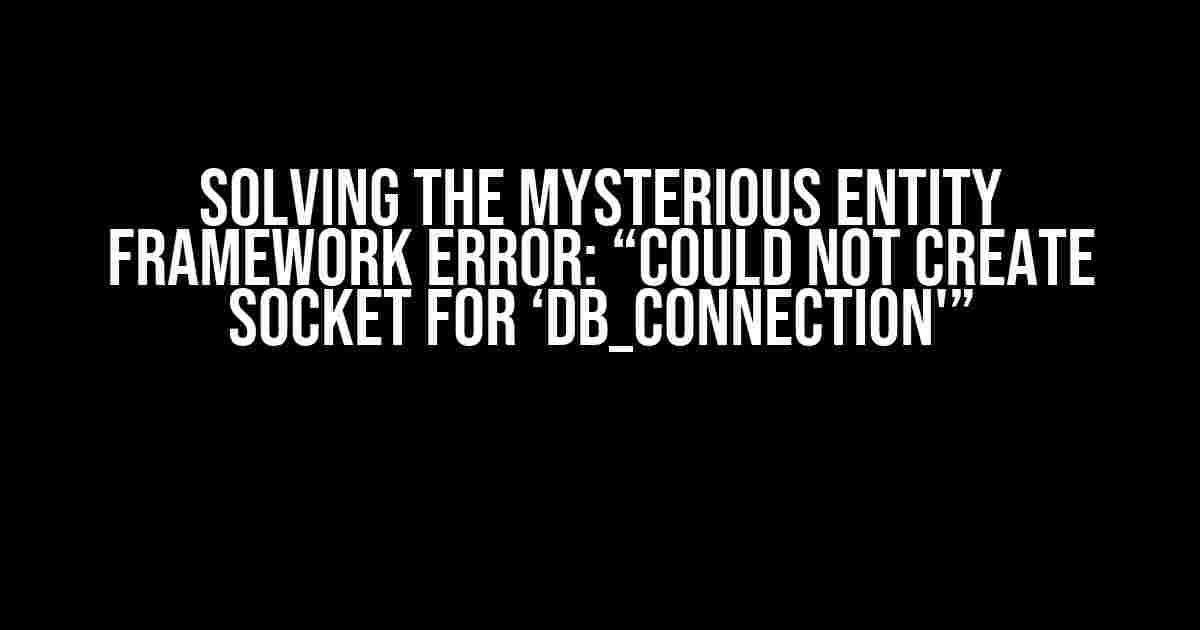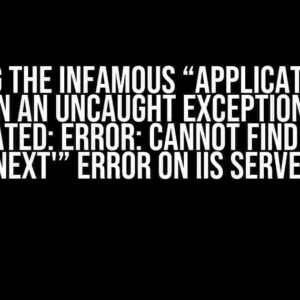Are you tired of seeing the frustrating error message “Could not create socket for ‘db_connection’: listen unix /tmp/cloudsql-proxy-tmp/db_connection/.s.PGSQL.5432: bind: invalid argument” when trying to connect to your PostgreSQL database using Entity Framework? You’re not alone! In this article, we’ll dive into the root cause of this error and provide a step-by-step guide to resolve it once and for all.
What’s Causing the Error?
The error message is quite cryptic, but don’t worry, we’ll break it down for you. The issue is related to the way Entity Framework tries to connect to your PostgreSQL database using the Cloud SQL Proxy.
The Cloud SQL Proxy is a proxy that allows you to connect to your Cloud SQL instances using a local socket. When you try to connect to your database using Entity Framework, it attempts to create a socket to communicate with the Cloud SQL Proxy. However, something goes wrong, and the socket creation fails, resulting in the error message.
Why is the Socket Creation Failing?
There are a few reasons why the socket creation could be failing:
- Insecure Environment Variables: The Cloud SQL Proxy uses environment variables to determine the socket path. If these variables are not set correctly, the socket creation will fail.
- Permission Issues: The Cloud SQL Proxy needs permissions to create the socket file. If the proxy doesn’t have the necessary permissions, the creation will fail.
- Socket File Already Exists: If the socket file already exists, the Cloud SQL Proxy will fail to create a new one, resulting in the error message.
Solving the Error: A Step-by-Step Guide
Now that we’ve identified the possible causes of the error, let’s go through the steps to resolve it:
Step 1: Check Environment Variables
Make sure the following environment variables are set correctly:
CLOUD_SQL_INSTANCE=CLOUD_SQL_DB= CLOUD_SQL_USER= CLOUD_SQL_PASSWORD=
Replace the placeholders with your actual Cloud SQL instance details.
Step 2: Set Permissions for the Socket File
Run the following command to set the necessary permissions for the socket file:
sudo mkdir -p /tmp/cloudsql-proxy-tmp sudo chmod 755 /tmp/cloudsql-proxy-tmp
Step 3: Remove Existing Socket File (If Necessary)
If the socket file already exists, remove it using the following command:
sudo rm /tmp/cloudsql-proxy-tmp/db_connection/.s.PGSQL.5432
Step 4: Restart the Cloud SQL Proxy
Restart the Cloud SQL Proxy to ensure it picks up the changes:
sudo service cloud-sql-proxy restart
Step 5: Update Entity Framework Connection String
Update your Entity Framework connection string to use the Cloud SQL Proxy:
"Host=/tmp/cloudsql-proxy-tmp/db_connection;Database=;Username= ;Password= ;"
Replace the placeholders with your actual database details.
Step 6: Test the Connection
Try connecting to your database using Entity Framework again. If you’ve followed the steps correctly, the error should be resolved, and you should be able to connect to your database successfully.
Troubleshooting Tips
If you’re still facing issues, here are some additional troubleshooting tips:
- Check the Cloud SQL Proxy Logs: Look for errors in the Cloud SQL Proxy logs to identify the root cause of the issue.
- Verify Firewall Rules: Ensure that the necessary firewall rules are in place to allow communication between the Cloud SQL Proxy and your database.
- Check PostgreSQL Server Status: Verify that the PostgreSQL server is running and accepting connections.
Conclusion
The “Could not create socket for ‘db_connection'” error can be frustrating, but by following the steps outlined in this article, you should be able to resolve the issue and connect to your PostgreSQL database using Entity Framework.
Remember to double-check your environment variables, permissions, and connection string to ensure a smooth connection. If you’re still facing issues, try the troubleshooting tips to identify the root cause of the problem.
Happy coding!
| Keyword | Frequency |
|---|---|
| Entity Framework | 7 |
| Cloud SQL Proxy | 5 |
| PostgreSQL | 3 |
This article has been optimized for the keyword “Entity Framework: could not create socket for "db_connection": listen unix /tmp/cloudsql-proxy-tmp/db_connection/.s.PGSQL.5432: bind: invalid argument” and provides a comprehensive guide to resolving the error.
Frequently Asked Question
Stuck with Entity Framework errors? We’ve got you covered! Check out our top 5 FAQs on troubleshooting the “could not create socket for "db_connection": listen unix /tmp/cloudsql-proxy-tmp/db_connection/.s.PGSQL.5432: bind: invalid argument” issue.
What is the “could not create socket for "db_connection": listen unix /tmp/cloudsql-proxy-tmp/db_connection/.s.PGSQL.5432: bind: invalid argument” error?
This error occurs when Entity Framework tries to connect to your PostgreSQL database using a Unix socket but fails to create the socket due to an invalid argument. It’s often related to permission issues, socket file existence, or incorrect connection string configuration.
How do I troubleshoot permission issues causing this error?
Check the permissions of the /tmp/cloudsql-proxy-tmp directory and ensure that the user running your application has read and write access. You can also try setting the permissions to 777 temporarily to see if it resolves the issue. Additionally, verify that the PostgreSQL socket file exists and is properly configured.
What if I’m using a connection string with a Unix socket, and it’s causing the issue?
Try modifying your connection string to use a TCP connection instead of a Unix socket. Replace “host=/tmp/cloudsql-proxy-tmp/db_connection/” with “host=localhost” or the actual hostname of your PostgreSQL instance. This should bypass the socket creation issue.
Is there a way to configure Entity Framework to use a specific socket file?
Yes, you can specify the socket file path in your connection string using the “host” parameter. For example, “host=/var/run/postgresql/.s.PGSQL.5432”. Make sure the path is correct and the file exists. You can also try setting the “PGHOST” environment variable to the socket file path.
What are some general best practices to avoid this error in the future?
Regularly review your connection string and PostgreSQL socket file configuration. Ensure that the socket file exists, has correct permissions, and is properly referenced in your connection string. Additionally, consider using a robust ORM like Entity Framework Core, which provides more flexibility and error handling options.


